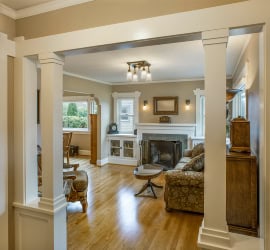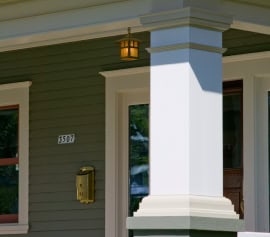
by Craftsman Design | Jul 19, 2013
A trendy, open floorplan can be tempting when you own a historic home. The space you have may feel too close or dark to be liveable. Before knocking down walls and installing track lighting in your Victorian, take a look at these five simple tips for historic home preservation and design:
Tip #1: Keep the floor plan clean and simple.
There is a certain hierarchy of public and private spaces that houses generally follow. Public spaces (like a front entry) often lead to other public spaces (like a living room or dining room), then to more private spaces (like a bathroom or bedroom).
Don’t remove walls in an attempt to “open up your floor plan” and end up with one giant room. Instead, half walls or columns can be utilized to keep the room open, yet allow a little separation and flow to your floor plan.
Tip #2: Keep the history in your home consistent.
Modernizing your home doesn’t mean you should give an ultra-modern interior to an Arts and Crafts home. You can upgrade your home, change the way the space flows, but keep touches of the original period. A transition from an older home on the outside to a modern interior is jarring and can reduce the home’s value.
Tip #3: Save and reinstall original pieces.
Keeping or reinstalling an original mantel, period-appropriate molding, or intricate knobs can keep the home’s character while allowing you to remodel it in order to match your 21st century needs.
Tip #4: Match the roofline and roof pitch
If you are looking to add on to your historical home, be sure to match the roofline and roof pitch. Changing the pitch or type of roofing makes it very obvious addition was installed. The addition of a dormer can also change your roofline, but when done properly, can look as if it was always there.
Tip #5: Add in your own family history
Don’t just buy pieces that fit with your home’s vintage, find family photos, furniture or quilts that you can use for your home. It’s your house, so bring in your own family history while you make more memories for generations to come.
We specialize in remodeling historic homes right here in Portland. Our services will take your project from design to build. Visit www.craftsmandesign.com today for examples of our award-winning designs.

by Craftsman Design | Jul 4, 2013
Historic preservation is one of our passions and specialities at Craftsman Design and Renovation. From design to build, we enjoy remodeling and preserving the classic homes of Portland.
It may seem like an overwhelming subject for a homeowner who cares for the history of their home, but also wants the space to cater to their modern needs. Here are some tips to help you both preserve and change your home to fit your needs:
1. Take a walk down your block
Your home probably fits right in with many other historic or period homes on your same block or in your neighborhood. If you are working to restore your home to its original structure or need help adding-on without the addition looking garish, take a stroll in your neighborhood. Study the homes surrounding yours. You may have a neighbor who pulled off exactly what you are trying to accomplish who you can learn from.
2. You can replace when necessary
There are times when a gorgeous old piece of molding or an ancient pillar is rotting away. Someone at a lumberyard may tell you that this piece is irreplaceable, but there are many times when this statement is untrue. Your old pillar may not be in stock, but Portland has many craftsmen who can design a match and keep your home’s integrity and beauty intact.
The same goes with old, intricate pieces like latches and door knobs. There are craftsmen, hardware shops, and antique shops which specialize in such pieces and can help you find the best match for or fix your broken piece.
3. Add your own history to the home
Your home may be historical, but so is your family line. Old photographs, your grandmother’s rocking chair or a quilted family tree can all add your own history to your home.
4. Decide what to change first
There are major changes that one can do to a home to restore it and there are small changes with a big impact. If your home needs repair before restoration, prioritize your projects and see if any overlap. For example: if you are planning to re-shingle the home with fish-scale shingles, and you have a leaky roof, you might as well do both at the same time.
5. Check in your attic, crawl spaces, and basement for original home parts
Previous owners may have stowed away original wainscotting, stained-glass windows, or even an original door in an unlikely corner of your home. This not only gives you a great original piece to use, but allows you some extra storage space as well.
6. Stay inspired
Restoring your home can feel like a long-term job, and sometimes it is. Seek out others with your passion, research your area, go on walking tours in historical neighborhoods and keep your passion burning.
We have restored and remodeled many historic homes in the Portland area. Our passion is helping homeowners blend their modern needs with their historical or period homes. You can find more tips and seek inspiration on our portfolio: <a href=”https://www.craftsmandesign.com/portfolio”>https://www.craftsmandesign.com/portfolio</a>.


